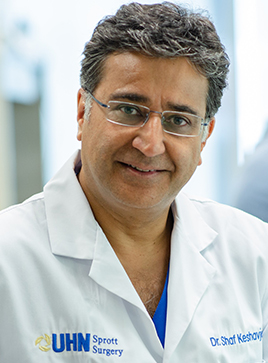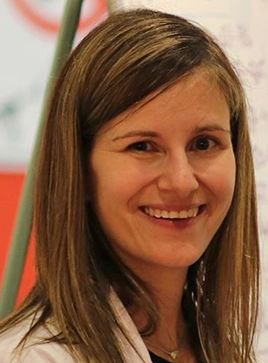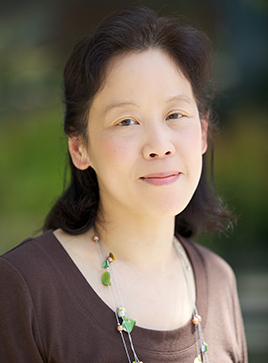COVID-19

Northern light: How Canadian research offers hope in the fight against COVID-19
It's probably safe to say that 2020 is not unfolding the way any of us had planned. Back in January, with all of our New Year's resolutions and hopes for the year, most Canadians could never have imagined that we would be facing a global pandemic just a few short months later. Such a rapid change sounded like the stuff of fiction—and yet, here we are.
The past few months have alternatively felt years long and like the blink of an eye, and while progress has certainly been made, there are no easy fixes. The COVID-19 pandemic—both here in Canada and around the globe—is not just one thing. We need medical countermeasures to diagnose, treat, and track the disease, but we also need social and policy countermeasures to reduce the spread and help people make healthy choices. We need to fight fear and misinformation, protect the vulnerable, and determine the safest ways to re-open and operate schools and workplaces. And we need the best evidence possible—as soon as possible—to do it all.
Science will guide us through this. But as tempting as it is to believe that science is a set of answers, the reality is that science is more like a process for figuring things out. No matter how messy it seems in the middle of that process as new evidence builds and assumptions change, it is our best way forward for tackling major societal challenges, including the pandemic.
Health research, in particular, is crucial. From the biomedical sciences that start with our cells to the public health initiatives that aim to keep whole populations safe and well, health research leads to improved disease diagnoses, more effective options for treatment, and a strengthened health care system overall.
This is a tall order to be sure, but Canada is home to exceptional people working in all areas of health research—and many of them are now directing their expertise to the messy but vital work of figuring out what we should do next.
Flattening the curve, reducing the strain
When the World Health Organization (WHO) was alerted to several cases of pneumonia in Wuhan, China, in December 2019, one of the most alarming parts of the report was the indication that the culprit did not match any other known virus. Scientists soon sequenced the entire genome of SARS-CoV-2, the virus we now know causes COVID-19 disease, but the fact remained that this was a new pathogen (at least for humans). The trouble with a new pathogen is that nobody is immediately immune to it, which allows it to spread more easily, and there are no proven treatments immediately available for those who became seriously ill.
But while the virus itself may be new to us, the study of viruses is not. Building on decades of research and the wealth of knowledge we have about how viruses interact with the human body, teams across Canada and around the world are currently working to develop potential vaccines and treatments to combat COVID-19.
While these teams conduct this painstaking and targeted work, the potential severity of illness remains another alarming aspect of the pandemic. The infection stemming from SARS-CoV-2 can vary widely from person to person: some people have no symptoms at all (often referred to as asymptomatic carriers), others will feel absolutely rotten but can recover at home, and a certain proportion will require hospitalization—possibly including intensive care and a ventilator.
This variation highlights the need to curb the spread of the virus and has led to the now-familiar rallying cries to "flatten the curve." While this emphasizes the need for individuals to reduce their own risk of contracting the virus, it is important to remember that an underlying goal of flattening the curve is to prevent our health care system from being overwhelmed. For example, we must remember that even if only 7% of COVID-19 cases become severe enough to require medical attention, our health care system is neither designed nor equipped to take care of 7% of Canada's population at one time. The result would be catastrophic: care would have to be rationed for those who do become sick with COVID-19 disease, and the system would lose much of its capacity to provide care for other medical needs, such as heart attacks, car accidents, and people living with chronic health conditions. We must also keep in mind the very real stress, trauma, and burnout experienced by health care providers—because the system would be nothing without the people behind it.

That is why Dr. Shaf Keshavjee, director of the Toronto Lung Transplant Program and surgeon-in-chief at University Health Network (UHN), is hoping that a diagnostic test to detect lung injury could help ease patients' minds and reduce the strain on resources.
Dr. Keshavjee and his team originally created the Rapid Acute Lung Injury Diagnostic test (RALI-Dx) during their organ transplantation research, which included developing a way to predict which donor lungs would stay healthy after transplantation and which ones would not. Using a blood sample, RALI-Dx looks for markers of early acute respiratory distress syndrome (ARDS)—which just happens to be the same type of lung injury that COVID-19 disease causes in those who become very sick. With new federal funding, Dr. Keshavjee's research will now focus on using the test in emergency departments to predict which patients have an increased risk of becoming severely ill.
"We aren't looking to diagnose the virus," he explains. "We're looking at the patient's response to it."
Although testing to diagnose COVID-19 disease is still an essential public health measure needed to isolate infected people, RALI-Dx could provide a much-needed triage measure to help emergency department staff determine which patients need to be admitted and which ones should be monitored at home. The test is currently being used within University Health Network hospital sites to establish its efficacy in predicting COVID-19 disease outcomes, but Dr. Keshavjee believes that wider use has the potential for profound impact on the health care system. Knowing which patients are at the highest risk of "running into trouble" because of the virus can lead to more efficient use of resources, which will help prevent the system from being overwhelmed—and could help emergency rooms deal with viral respiratory illness in the future.
"The beauty of this test is that it doesn't even matter what virus is causing the problem," he notes. "We could use it in the emergency room during any flu season or with bouts of any flu-like illness—and if the patient isn't experiencing a strong inflammatory response, they can be triaged accordingly, because we'll know that they're safe to recover at home."
Tracking the virus, tracing the spread
In addition to figuring out how to best prioritize and treat individual patients, Canadian researchers are working to better understand how the SARS-CoV-2 virus is spreading. Physical distancing and other public health measures are in place because we know that the virus can be passed between individuals through the droplets that an infected person expels when they cough, sneeze, or speak, but public health officials also need a bird's eye view of entire populations in order to develop appropriate responses.

Dr. Natalie Prystajecky, a clinical assistant professor at the University of British Columbia and the program head for the Environmental Microbiology program at the British Columbia Centre for Disease Control (BCCDC) Public Health Laboratory, is aiming to use the latest in genomics technology to provide that big picture.
The relatively young field of genomics involves analyzing the structure and function of an organism's entire genome. Although the full genetic code of SARS-CoV-2 was sequenced in January 2020, the need for genomics research doesn't end with that one complete map. Building on work that she and her colleagues were able to start in February, Dr. Prystajecky is now working on a new project to track and map changes in the genome of SARS-CoV-2 as it passes from person to person.
Changes in a virus are a natural part of its lifecycle. A virus must replicate millions of times as it infects more cells, and sometimes that replication leads to mistakes. When these mistakes produce a change in the genomic sequence, the result is a mutation. While that sounds worrisome, these individual changes are more akin to a typo than a plot twist, and they allow researchers to map any change to the known genetic sequence(s)—which means that paths of transmission can be tracked.
"We can look at little clusters of illness to see how it has been spread," Dr. Prystajecky explains, noting that this information can shape public health responses because it can help pinpoint where the infection was introduced. "It's similar to the methodology we've used to track salmonella outbreaks, so we're building on that type of experience."
Gathering evidence to navigate policies
For many, the idea of medical countermeasures against a virus is somewhat tangible, even if it conjures images based more on the laboratories in movies than those in real life. The idea of policy and social countermeasures can seem comparatively abstract—but the effects of those countermeasures have a significant impact on each and every one of us, as recent policies around lockdowns, travel restrictions, and border closures have shown.

It is one thing to enact these measures, but it is another thing entirely to know whether they are working, how they could be improved, and when they can be lifted. In those instances—as with so many other aspects of the pandemic—data is the best medicine.
"Should a border be closed? If so, for how long? Does temperature screening actually work? If not, what else should we do to screen people at airports? And what domestic measures need to be put into place in combination with measures at the border?" asks Dr. Kelley Lee, a professor in the Faculty of Health Sciences at Simon Fraser University and Canada Research Chair in Global Health Governance. "These are really complex questions that require better data analysis in real time as policy and decision makers navigate our next steps."
Dr. Lee is working on a project to help serve these data needs. Lessons from past health crises have already taught us that coordination across regions and countries is key to successfully detecting, controlling, and mitigating disease outbreaks, but coordination is a complex challenge that involves multiple levels of governance and requires timely access to accurate information. Dr. Lee and her team are therefore collecting details about the cross-border measures currently in place around the world (such as trade and travel bans or restrictions, compulsory quarantines, and screening practices), as well as the most up-to-date data about the efficacy of those measures. With this information, the team plans to create a data analysis tool that will help public health officials and political leaders make evidence-based decisions about cross-border measures—and by improving how those measures are used, the team's goal is to improve how countries coordinate their responses to COVID-19 overall.
"In a nutshell, we want to make sure that decisions about cross-border measures—that is, what those measures are, when they should be adopted, and when they can be removed—are taken for the right reasons," Dr. Lee explains. "Coordination is really the basis of effective collective action."
Pushing back against the "noise"
For most, the pandemic has been extremely disorienting. Whether we are exercising, caring for loved ones or simply shopping for groceries, it can be difficult to know what steps to take to safeguard our own health and that of others. This has understandably left many turning to social media and other online sources to seek comfort and search for new information. These common practices were well established in our lives before the pandemic, but information-seekers today are likely to find a lot more than they bargained for.

"There is an astronomical amount misinformation circulating about the coronavirus right now," says Professor Timothy Caulfield, Research Director of the Health Law Institute at the University of Alberta, who has been studying the spread and impact of health misinformation for decades. "It's unprecedented. I've never seen anything like it."
Misinformation is "an incredibly complex social phenomenon," says Professor Caulfield. The newness of the SARS-CoV-2 virus and the massive societal disruptions related to the pandemic have created fertile ground for misinformation in a variety of forms, ranging from conspiracy theories about the origin of the virus to potentially dangerous (or even deadly) advice about prevention and "cures." In addition to promoting unproven products or activities to fight infection, misinformation can quickly become full-blown propaganda, often with the potential to amplify racism, stoke distrust in experts, or undermine the best public health strategies.
Professor Caulfield is leading a new project to battle this onslaught of misleading and harmful messaging about the SARS-CoV-2 virus and COVID-19 disease. To get a handle on the current situation, his team is scouring social media platforms, mainstream media news stories, and search engine data to see how people are searching for information—and what they find when they do. They are documenting the nature, scope, and sources of misinformation about the pandemic, but they are also studying human behaviour (how people respond to the misinformation) to determine which types of messages are gaining traction and why.
In a second phase of the project, the team will combine these insights to create an evidence-based blueprint to outline ways for governments, companies, the media, and the general public to "push back against the noise" of misinformation, whether it's about the COVID-19 pandemic or a future event.
Dispelling misinformation can be frustratingly complicated, especially since so many of us are inclined to believe that we're not susceptible to it in the first place. But misinformation becomes increasingly harmful to individuals and entire communities if it is left to fester, which is why we all have a role in stopping it. This is exactly where evidence-based social countermeasures kick in, with research better equipping us for the battle against scientific bunk.
"We need to know what misinformation is out there related to COVID-19, and then we need to find ways to have a meaningful impact against it," explains Professor Caulfield. "We need research to see what really works—and then we'll use it. But I do hope a legacy of this crisis will be the broad recognition of the value of good science and that we learn from the harm of bad information and pseudoscience."
And when it comes to good science—whether it's strengthening the health care system, offering medical countermeasures, charting the social impacts of the pandemic or exposing misinformation—Canadian researchers have got us covered.
The projects featured in this story have been chosen to provide an overview of the various ways in which health research is contributing to Canada's response to the COVID-19 pandemic. To learn about more COVID-19 research taking place across the country, browse through individual project profiles.
- Date modified: